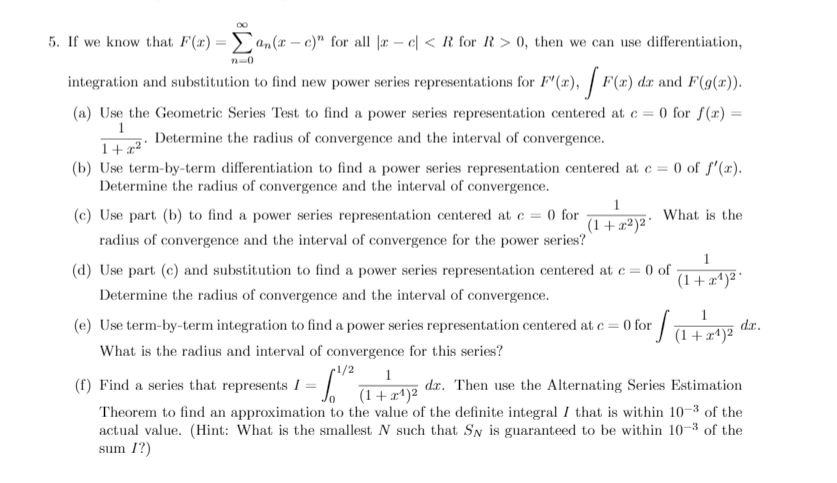(a) Use the Geometric Series Test to find a power series representation centered at e = 0 for f(r) 1 Determine the radius of convergence and the interval of convergence. 1+x²° (b) Use term-by-term differentiation to find a power series representation centered at e = 0 of f'(x). Determine the radius of convergence and the interval of convergence. (c) Use part (b) to find a power series representation centered at e = 0 for radius of convergence and the interval of convergence for the power series? 1 (1+ x²)2* What is the (d) Use part (c) and substitution to find a power series representation centered at e = 1 c = 0 of (1+x*)²' Determine the radius of convergence and the interval of convergence. (e) Use term-by-term integration to find a power series representation centered at e= (0 for dr. What is the radius and interval of convergence for this series?
(a) Use the Geometric Series Test to find a power series representation centered at e = 0 for f(r) 1 Determine the radius of convergence and the interval of convergence. 1+x²° (b) Use term-by-term differentiation to find a power series representation centered at e = 0 of f'(x). Determine the radius of convergence and the interval of convergence. (c) Use part (b) to find a power series representation centered at e = 0 for radius of convergence and the interval of convergence for the power series? 1 (1+ x²)2* What is the (d) Use part (c) and substitution to find a power series representation centered at e = 1 c = 0 of (1+x*)²' Determine the radius of convergence and the interval of convergence. (e) Use term-by-term integration to find a power series representation centered at e= (0 for dr. What is the radius and interval of convergence for this series?
Algebra & Trigonometry with Analytic Geometry
13th Edition
ISBN:9781133382119
Author:Swokowski
Publisher:Swokowski
Chapter10: Sequences, Series, And Probability
Section10.2: Arithmetic Sequences
Problem 68E
Related questions
Question
Need help with parts d -f, and with part d its okay if I just get the power series for it without using part c to find it.

Transcribed Image Text:5. If we know that F(x) =an(x – c)" for all |r – e| < R_for R > 0, then we can use differentiation,
n-0
integration and substitution to find new power series representations for F (x), | F(x) dx and F(g(x)).
(a) Use the Geometric Series Test to find a power series representation centered at e = 0 for f(x) =
1
1+x² '
(b) Use term-by-term differentiation to find a power series representation centered at e = 0 of f'(x).
Determine the radius of convergence and the interval of convergence.
Determine the radius of convergence and the interval of convergence.
1
(c) Use part (b) to find a power series representation centered at e = 0 for
(1 + x²)² °
What is the
radius of convergence and the interval of convergence for the power series?
1
(d) Use part (c) and substitution to find a power series representation centered at e= 0 of
(1 + x*)² *
Determine the radius of convergence and the interval of convergence.
(e) Use term-by-term integration to find a power series representation centered at e = 0 for
dr.
What is the radius and interval of convergence for this series?
r1/2
1
(f) Find a series that represents I = (1+#^)2
Theorem to find an approximation to the value of the definite integral I that is within 10-3 of the
actual value. (Hint: What is the smallest N such that SN is guaranteed to be within 10–3 of the
sum 1?)
dr. Then use the Alternating Series Estimation
Expert Solution
This question has been solved!
Explore an expertly crafted, step-by-step solution for a thorough understanding of key concepts.
Step by step
Solved in 5 steps

Knowledge Booster
Learn more about
Need a deep-dive on the concept behind this application? Look no further. Learn more about this topic, advanced-math and related others by exploring similar questions and additional content below.Recommended textbooks for you

Algebra & Trigonometry with Analytic Geometry
Algebra
ISBN:
9781133382119
Author:
Swokowski
Publisher:
Cengage

Algebra & Trigonometry with Analytic Geometry
Algebra
ISBN:
9781133382119
Author:
Swokowski
Publisher:
Cengage